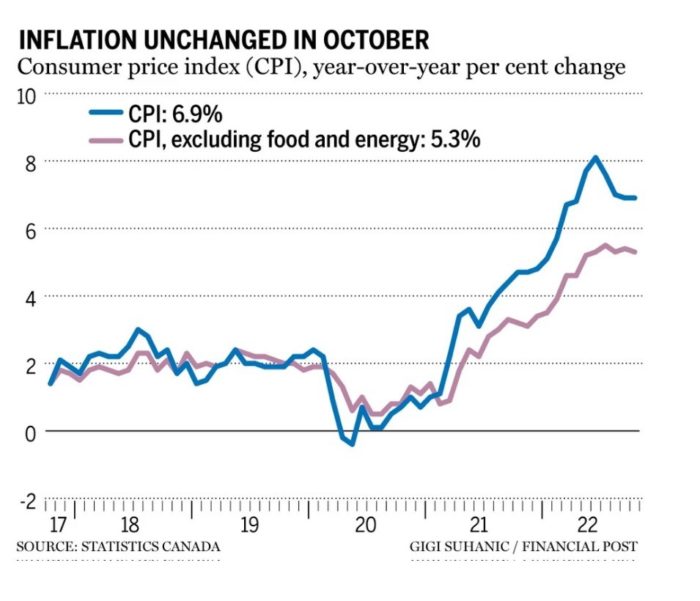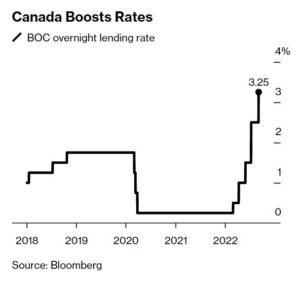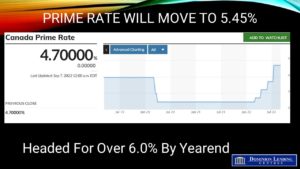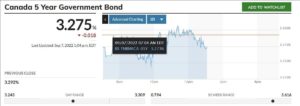While Toronto has seen a significant dip in home prices as borrowing costs have gone up over the past year, other places in Ontario are seeing an even more dramatic drop according to a new report released Monday.
The report, from economists at financial services company Desjardins, examined the Ontario housing market in the context of recent developments, such as interest rate hikes and supply. It found that Ontario is projected to see the biggest correction compared to other provinces in Canada, an anticipated 25 per cent drop by the end of 2023 from the market’s peak. However within Ontario, the GTA is not the location where prices are projected to fall the most.
“Given nearly half of existing home sales take place in the Greater Toronto Area (GTA), that market tends to garner the most attention,” the report notes. “But during the pandemic, it was surrounding communities that grabbed more of the headlines. Home prices rose significantly in the GTA, but not nearly as much as they did in smaller Ontario communities or nationally for that matter. And these places are expected to continue seeing the biggest correction.”
Places like Windsor, Oshawa, Sudbury and London saw skyrocketing home prices from Dec. 2019 to the market’s peak during the pandemic, rising between 75 per cent to close to 100 per cent in a short period. But that means there’s a long way to fall from those peaks now that the real estate market has cooled off.
Bancroft is expected to see the steepest decline in home prices by the end of the year, with a projected 50 per cent drop. That’s followed by Northumberland Hills (-42 per cent), Woodstock-Ingersoll (-40 per cent), Grey Bruce Owen Sound (-39 per cent) and Muskoka & Haliburton (-39 per cent).
Areas where the price is expected to fall roughly 30-38 per cent by the end of the year include Durham, London, Windsor, Guelph, Peterborough, Barrie, Orilia, Kitchener, Niagara Falls and other areas.
While prices in the GTA are still projected to fall by the end of 2023, the drop is anticipated to be softer, more like 20 per cent from peak.
Mississauga (-23 per cent), York Region (-19 per cent), Ottawa (-20 per cent), Timmins (-20 per cent) and Thunder Bay are also projected to see drops of less than 25 per cent.
“While analysts and the media follow Toronto and all‑Ontario real estate data closely, there is significant variability across communities within Canada’s largest province. Supported by buyers’ desire for more space when working and educating children from home, homebuying activity surged most significantly in smaller Ontario centres during the pandemic,” the report’s authors write. “While we expect home sales and values to find a bottom in the second half of 2023, these smaller cities should continue to experience some of the most pronounced corrections in Ontario.”
The report says the “erosion of affordability has made life challenging for households across Ontario” and calls for the provincial government to be mindful of smaller communities when proceeding with its housing plan.
“As policymakers move forward on ambitious plans to increase the housing supply to improve affordability, considering local market needs will be of paramount importance,” the report states.
PROJECTED DROPS FOR 2023 ACCORDING TO DESJARDINS
Bancroft -50%
Northumberland Hills -42%
Woodstock-Ingersoll -40%
Grey Bruce Owen Sound -39%
Muskoka & Haliburton -39%
Chatham Kent -38%
Welland -38%
Windsor-Essex -37%
Peterborough & the Kawarthas -37%
St Catharines -37%
Niagara Falls-Fort Erie -36%
Parry Sound -36%
London and St Thomas -36%
Guelph -35%
Tillsonburg -34%
Quinte -34%
Huron Perth -34%
Brantford -34%
Kawartha Lakes -33%
Durham Region -33%
Cambridge -32%
Simcoe -32%
Kitchener-Waterloo -32%
Barrie -31%
Orillia -30%
Hamilton-Burlington -30%
Rideau-St Lawrence -30%
North Bay -30%
Cornwall -30%
Orangeville -29%
Southern Georgian Bay West -29%
Sudbury -28%
Sault Ste Marie -28%
Southern Georgian Bay East -28%
Renfrew -27%
Sarnia-Lambton -27%
Oakville-Milton -24%
Kingston -24%
Mississauga -23%
Greater Toronto -20%
Ottawa -20%
Timmins -20%
York Region -19%
Source: CP24 https://www.cp24.com/news/these-are-the-ontario-communities-that-are-expected-to-see-the-biggest-home-price-declines-1.6301182








 If you are in the market for a home or a new car, you are probably very familiar with your credit score. Lenders are one of the primary users of credit scores and it can have a huge impact on whether you get approved for a loan and just how much interest it is going to cost you. What isn’t well known about credit scores is where they come from, what makes them go up (or down!) and who else besides potential lenders uses them to make decisions? Your credit score is going to be with you for life, so why not take a couple of minutes to get the facts.
If you are in the market for a home or a new car, you are probably very familiar with your credit score. Lenders are one of the primary users of credit scores and it can have a huge impact on whether you get approved for a loan and just how much interest it is going to cost you. What isn’t well known about credit scores is where they come from, what makes them go up (or down!) and who else besides potential lenders uses them to make decisions? Your credit score is going to be with you for life, so why not take a couple of minutes to get the facts.



